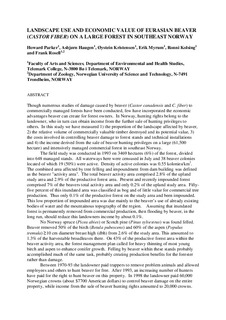| dc.description.abstract | Though numerous studies of damage caused by beaver (Castor canadensis and C. fiber) to commercially managed forests have been conducted, few have incorporated the economic advantages beaver can create for forest owners. In Norway, hunting rights belong to the landowner, who in turn can obtain income from the further sale of hunting privileges to others. In this study we have measured 1) the proportion of the landscape affected by beaver, 2) the relative volume of commercially valuable timber destroyed and its potential value, 3) the costs involved in controlling beaver damage to forest stands and technical installations and 4) the income derived from the sale of beaver hunting privileges on a large (61,500 hectare) and intensively managed commercial forest in southeast Norway. The field study was conducted in 1993 on 3469 hectares (6%) of the forest, divided into 648 managed stands. All waterways here were censused in July and 38 beaver colonies located of which 19 (50%) were active. Density of active colonies was 0.55 kolonies/km2. The combined area affected by tree felling and impoundment from dam building was defined as the beaver "activity area". The total beaver activity area comprised 2.8% of the upland study area and 2.9% of the productive forest area. Present and recently impounded forest comprised 7% of the beavers total activity area and only 0.2% of the upland study area. Fiftyfive percent of this inundated area was classified as bog and of little value for commercial tree production. Thus only 0.1% of the productive forest on the study area and been impounded. This low proportion of impounded area was due mainly to the beaver’s use of already existing bodies of water and the mountainous topography of the region. Assuming that inundated forest is permanently removed from commercial production, then flooding by beaver, in the long run, should reduce this landowners income by about 0.1%. No Norway spruce (Picea abies) or Scotch pine (Pinus sylvestrus) was found felled. Beaver removed 50% of the birch (Betula pubescens) and 60% of the aspen (Populus tremula) ≥10 cm diameter breast high (dbh) from 2.6% of the study area. This amounted to 1.3% of the harvestable broadleaves there. On 43% of the productive forest area within the beaver activity area, the forest management plan called for heavy thinning of most young birch and aspen to enhance conifer growth. Felling by beaver within these stands probably accomplished much of the same task, probably creating production benefits for the forester rather than damage. Between 1970-93 the landowner paid trappers to remove problem animals and allowed employees and others to hunt beaver for free. After 1993, an increasing number of hunters have paid for the right to hunt beaver on this property. In 1998 the landowner paid 60,000 Norwegian crowns (about $7700 American dollars) to control beaver damage on the entire property, while income from the sale of beaver hunting rights amounted to 20,000 crowns. Based on estimates of population density, it is predicted that about 10 times as many beaver could be harvested from the property on a sustained basis as were removed in 1998. With the present rapid increase in demand for beaver hunting, income from hunting may soon surpass the cost of controlling damage for this landowner. Due to initial high densities of broadleaves following clear-cutting, it was predicted that intensive forestry practices may actually enhance beaver density. At the landscape level, the presence of beaver is likely to increase biodiversity in commercial forests - a major goal of Norwegian forest management. | |
